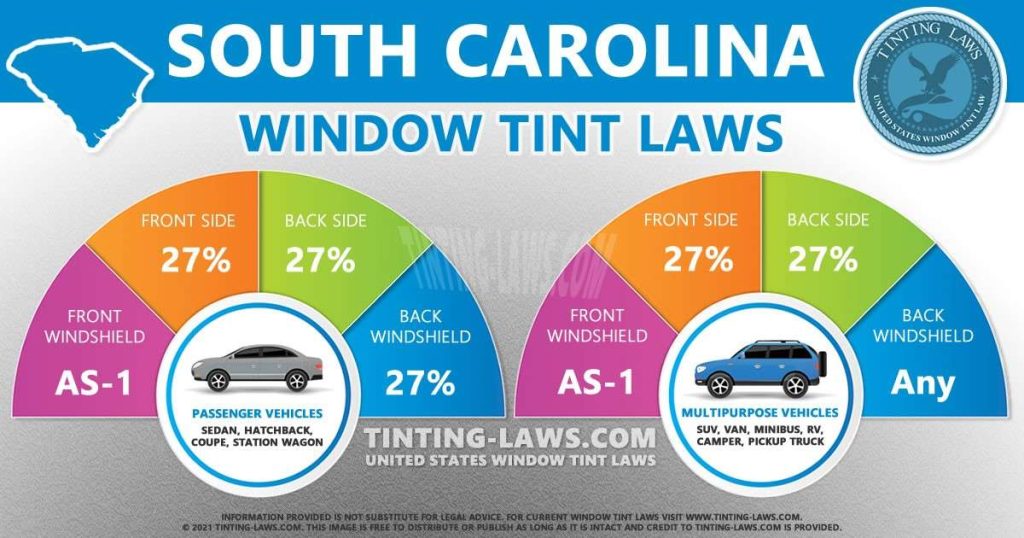South Carolina Window Tinting Laws
Car window tinting laws in South Carolina were enacted in 1992.
We have provided all the necessary information about your car’s window tint, including how dark or reflective the tint is allowed in your state.
There are also additional car window tinting rules and regulations in South Carolina so make sure you read all about it below.
Window tint darkness in South Carolina
The percent of visible light allowed through your car windows is called VLT: Visible Light Transmission.
The percentage of light allowed through your film and glass in South Carolina is very specific and different for sedan cars and SUV cars or vans.
Tint darkness for sedans:
- Windshield: Non-reflective tint is allowed above the manufacturer’s AS-1 line.
- Front Side windows: Must allow more than 27% of light in.
- Back Side windows: Must allow more than 27% of light in.
- Rear Window: Must allow more than 27% of light in.
Tint darkness for SUV and vans:
- Windshield: Non-reflective tint is allowed above the manufacturer’s AS-1 line.
- Front Side windows: Must allow more than 27% of light in.
- Back Side windows: Any darkness can be applied several (unspecified) inches from the top of the window.
- Rear Window: Any darkness can be used.
Window tint reflection in South Carolina
Window tint can reflect incoming light and reduce glare and heat.
South Carolina window tint law permits a certain window reflection when using a tint so make sure you pay attention to this as well.
Tint reflection for sedans:
- Front Side windows: Must be non reflective, state law is not specific about what this means.
- Back Side windows: Must be non reflective, state law is not specific about what this means.
Tint reflection for SUV and vans:
- Front Side windows: Must be non reflective, state law is not specific about what this means.
- Back Side windows: Must be non reflective, state law is not specific about what this means.
Other South Carolina window tint rules and regulations:
South Carolina does have several other important laws, rules and regulations pertaining to window tinting. They include the following:
- Side Mirrors: Dual side mirrors are required if back window is tinted.
- Restricted Colors: Tint colors red, amber and yellow are not permitted by law.
- Certificates: Film manufacturers need to certify the film they sell in South Carolina. Check with your dealer if they are using certified film.
- Stickers: The sticker to identify legal tinting is required between the film & glass on each tinted window.
- Medical Exceptions: South Carolina allows medical exemptions for special tint. For more details about the specific terms of the exemption, consult your state law.
- Penalties: Misdemeanor with minimum $200 fine or 30 days in prison for each offense.
Keep in mind that South Carolina tinting laws and regulations may be interpreted differently in your county or place of residence.
We always recommend double-checking our information with your local DMV or law enforcement authorities.

Our information about window tint laws in South Carolina was last updated in 2024.
Tinting laws in South Carolina were enacted in 1992.
In case any of our info provided is not up to date or correct be sure to contact us so we can fix it. Thanks!
Trusted industry leader in providing accurate window tint laws. Share with confidence:
State of South Carolina Info
South Carolina is a state in the Southeastern United States.
It is bordered to the north by North Carolina; to the south and west by Georgia, located across the Savannah River; and to the east by the Atlantic Ocean.

It’s the 40th most extensive and the 24th most populous of the 50 United States, and comprises of 46 counties.
The capital and largest city of the state is Columbia.
Capital: Columbia
Population: 5,190,705
Area: 32,020 sq mi (82,931. km2)
Cities in South Carolina: Charleston, Myrtle Beach, Greenville, Columbia, Hilton Head Island, Spartanburg, Mount Pleasant, Summerville, Beaufort, North Charleston, Rock Hill, Florence, Anderson, Bluffton, Fort Mill, Isle of Palms, Aiken, Pawleys Island, Sumter, Folly Beach, Greer, Conway, Murrells Inlet, North Myrtle Beach, Simpsonville, Goose Creek, Georgetown, Surfside Beach, Lexington, Orangeburg, Sullivan’s Island, Moncks Corner, Clemson, Gaffney, Greenwood, Parris Island, Easley, Seabrook Island, Walterboro, Irmo, Hartsville, Seneca, Camden, Edisto Beach, North Augusta, West Columbia, Travelers Rest, Edgefield, Mauldin, Blythewood
Counties in South Carolina: Abbeville, Aiken, Allendale, Anderson, Bamberg, Barnwell, Beaufort, Berkeley, Calhoun, Charleston, Cherokee, Chester, chesterfield, clarendon, Colleton, Darlington, Dillon, Dorchester, Edgefield, Fairfield, Florence, Georgetown, Greenville, Greenwood, Hampton, Horry, Jasper, Kershaw, Lancaster, Laurens, Lee, Lexington, Marion, Marlboro, McCormick, Newberry, Oconee, Orangeburg, Pickens, Richland, Saluda, Spartanburg, Sumter, Union, Williamsburg, York
Tint law references:
South Carolina Code of Laws section 56-5-5015: Sunscreen devices. (scroll to section 56-5-5015)